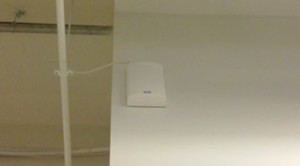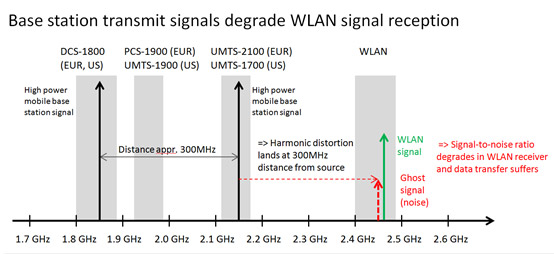Blog
This may come as a surprise to many experts, but mobile networks generate interference to WLAN networks and may clearly degrade WLAN performance. Most would not think to consider this as a relevant source of Wi-Fi interference, however, I explain below how we identified the issue and got one organization back on the path to high performance WLAN.
The Challenge
We were contacted by an organization who indicated they had WLAN performance issues. They had an enterprise grade WLAN network designed and implemented with Cisco technology. They also had an important need for mobile phones to function both indoors as well as outdoors. However, the signal strength of the mobile carrier did not penetrate the building sufficiently which resulted in the need for additional indoor mobile coverage. This was  accomplished by placing a Nokia Siemens Networks (NSN) macro mobile base station in the basement and distributing RF signals over coax cables with RF splitters to multiple locations inside the building. 2G and 3G mobile signals were delivered through directional indoor base station antennas placed on the walls. This delivery architecture was considered standard and known as a best practice for delivering mobile signals indoors.
accomplished by placing a Nokia Siemens Networks (NSN) macro mobile base station in the basement and distributing RF signals over coax cables with RF splitters to multiple locations inside the building. 2G and 3G mobile signals were delivered through directional indoor base station antennas placed on the walls. This delivery architecture was considered standard and known as a best practice for delivering mobile signals indoors.
The Solution and Results
Our system of WLAN performance management was put in place to monitor, measure and identify network issues. We began the process of continuous end user experience testing and measurement as well as analyzing radio conditions in detail from multiple perspectives.
It turned out that as relatively high level 2G and 3G signals hit the WLAN access point and terminal receivers, these signals generated “ghost” signals (third order harmonic distortion products) inside the WLAN receiver circuitry. These signals fall directly on the 2.4 GHz WLAN band and degrade both reliability and data speeds.

Conclusions
The root cause for this problem was that WLAN receivers did not have any meaningful filtering for off-band signals. This filtering cannot be added afterwards either and as mentioned above, this allows high level downlink mobile base station signals to create "ghost signals" within the WLAN receivers. When an external band pass filter was inserted in the test setup, the ghosts disappeared, confirming the root cause. This case was also analyzed and verified with NSN experts.
Its complex out there and interference may be coming from sources you would not typically think of first. As a WLAN specialist you need to take big perspectives and see the larger RF picture. To be sure you know what’s happening in your network, use a system of performance management to continually test and measure so that you can rid yourself of these Wi-Fi performance ghosts once and for all.
-VP
Click below if you would like to set up time to see a demo of our Wi-Fi performance management system.